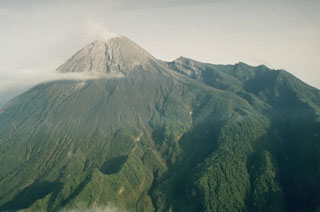Report on Merapi (Indonesia) — 4 June-10 June 2025
Smithsonian Institution / US Geological Survey
Weekly Volcanic Activity Report, 4 June-10 June 2025
Managing Editor: Sally Sennert.
Please cite this report as:
Global Volcanism Program, 2025. Report on Merapi (Indonesia) (Sennert, S, ed.). Weekly Volcanic Activity Report, 4 June-10 June 2025. Smithsonian Institution and US Geological Survey.
Merapi
Indonesia
7.54°S, 110.446°E; summit elev. 2910 m
All times are local (unless otherwise noted)
The Balai Penyelidikan dan Pengembangan Teknologi Kebencanaan Geologi (BPPTKG) reported that the eruption at Merapi (on Java) continued during 30 May-5 June. Seismicity remained at high levels, similar to the previous week. The SW lava dome produced 20 lava avalanches that traveled as far as 1.9 km SW down the Bebeng drainage, 14 that traveled as far as 2 km SW down the Krasak drainage, and 39 that traveled as far as 2 km W down the Sat/Putih drainage. Small morphological changes to the SW lava dome resulted from continuing effusion and minor collapses. The hottest temperature at the SW dome was 247.4 degrees Celsius, the same as the previous measurement, and the volume of the dome increased by 52,500 cubic meters to an estimated 4,049,300 cubic meters, based on webcam images and a 30 May drone survey. The size of the central dome had not changed, and the highest temperature remained relatively stable at 217.9 degrees Celsius. The Alert Level remained at 3 (on a scale of 1-4), and the public was warned to stay 3-7 km away from the summit, based on location.
Geological Summary. Merapi, one of Indonesia's most active volcanoes, lies in one of the world's most densely populated areas and dominates the landscape immediately north of the major city of Yogyakarta. It is the youngest and southernmost of a volcanic chain extending NNW to Ungaran volcano. Growth of Old Merapi during the Pleistocene ended with major edifice collapse perhaps about 2,000 years ago, leaving a large arcuate scarp cutting the eroded older Batulawang volcano. Subsequent growth of the steep-sided Young Merapi edifice, its upper part unvegetated due to frequent activity, began SW of the earlier collapse scarp. Pyroclastic flows and lahars accompanying growth and collapse of the steep-sided active summit lava dome have devastated cultivated lands on the western-to-southern flanks and caused many fatalities.
Source: Balai Penyelidikan dan Pengembangan Teknologi Kebencanaan Geologi (BPPTKG)

